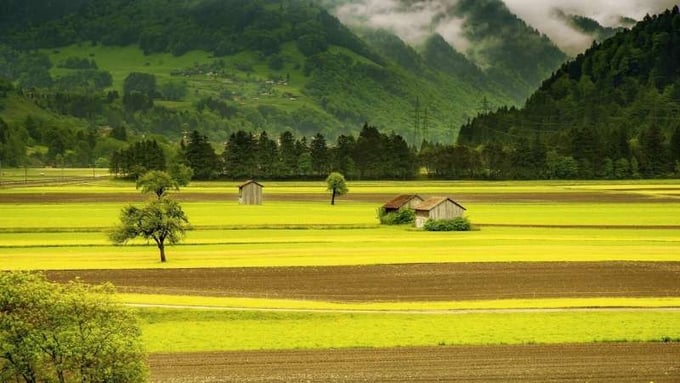May 24, 2025 | 05:07 GMT +7
May 24, 2025 | 05:07 GMT +7
Hotline: 0913.378.918
May 24, 2025 | 05:07 GMT +7
Hotline: 0913.378.918
Climate change, natural resource depletion, soil erosion, and fossil fuel use in farming make the task even more challenging. We need to do something differently, but what?

Photo: Pixabay/CC0 Public Domain
Barath Raghavan, an associate professor of computer science at USC Viterbi, is rethinking traditional farming practices by developing computational tools to help farmers design, develop, and manage sustainable farming methods. Raghavan, a member of the California Rare Fruit Growers organization, currently grows more than 150 different edible plants in his yard. A decade ago, he started to combine his interests by researching how computing could make agriculture more sustainable.
Raghavan calls this new area of research "computational agroecology," uniting technology and farming expertise to develop diverse agricultural landscapes based on natural ecosystems. From crop selection to planting to irrigation, the method allows farmers to explore thousands of different potential designs to optimize food production without fossil fuel-derived pesticides.
"How can we design an ecosystem that is as productive and sustainable as a natural forest, but instead of producing food for wildlife, it's producing food for people?" said Raghavan.
"It's an incredibly hard problem because designing an ecosystem is a super complex, dynamic, natural system. We're trying to build computing tools that can figure out how ecosystems work, so we can grow food plentifully and sustainably."
'A totally new way to think about agriculture'
In a new paper published in PNAS Nexus on March 16, Raghavan and his colleagues propose "a totally new way to think about agriculture and the benefits it can have for research and farming," said Raghavan.
In this study, the researchers reconceptualize agriculture as a search through a "state space," which represents all possible configurations of a system—in this context, agricultural land.
To better understand the concept of a state space, imagine a box of blocks: Each block could be red, blue or yellow. The state space would consist of all the possible ways to arrange these blocks, such as all red, blue or green, or a combination of the three colors.
In the same way, a state space for an agricultural system might consist of all the possible variables that the system can take—such as crop or soil type, weather conditions, irrigation, fertilization or pest control.
This allows agricultural researchers and farmers to explore the different paths and strategies available—taking different "blocks" or variables and placing them together to see what works; essentially, an agricultural "sandbox" to determine optimal configurations to increase crop yield, improve sustainability, and discover entirely new combinations of crops that grow well together.
For instance, the framework enables analytics and machine learning that could allow researchers to analyze the patterns between crop yield and soil moisture content or simulate growing different types of crops together for biodiversity.
"Once we can conceive of a farm this way, we can then reframe many research questions and farming planning questions as a search through the space of all possible states the farm could possibly end up in, with certain states being more desirable than others," said Raghavan.
"This allows us to compare and contrast different approaches to farming, explore and combine techniques, and then search the state space in simulation for new farming techniques that have never been tried before and where trial and error in the real world would be far too expensive and time-consuming."
'Playing a chess game with nature'
For example, in Southern California, farmers have recently discovered that high-quality coffee can grow plentifully between avocado trees. But figuring out the right way to do that, and maybe even add another couple of crops that work well together, is site-specific.
"Each farmer doesn't have the time or ability to do trial and error for years to figure out the right way to grow a half dozen crops on their land," said Raghavan.
"Instead, with the conceptual framework and eventually software framework of state spaces, a farmer could spell out an objective—such as diversified harvest with high yield and possible high profit for a specific piece of land—and have the system explore the state space and produce possible plant mixtures, placement, and management techniques that meet the farmer's criteria."
Raghavan compares the process to "playing a chess game with nature, but one that is both competitive and collaborative."
"You're making moves on the chessboard, which is your land, and nature is making moves too. Pests are going to eat one crop; a flood is going to damage another. What we are building is a computational framework that allows you to explore all the different ways that you might 'play' this game of chess with nature so that we can come up with the best one for your land."
The team is now working through possible use cases with researchers and farmers to incorporate specific use cases and to develop software that can make it easy to simulate and explore state spaces.
(Phys.org)

(VAN) Alt Carbon has raised $12 million in a seed round as it plans to scale its carbon dioxide removal work in the South Asian nation.

(VAN) Attempts to bring down the price of the Japanese staple have had little effect amid a cost-of-living crisis.

(VAN) Fourth most important food crop in peril as Latin America and Caribbean suffer from slow-onset climate disaster.

(VAN) Shifting market dynamics and the noise around new legislation has propelled Trouw Nutrition’s research around early life nutrition in poultry. Today, it continues to be a key area of research.

(VAN) India is concerned about its food security and the livelihoods of its farmers if more US food imports are allowed.

(VAN) FAO's Director-General emphasises the need to work together to transform agrifood systems.

(VAN) Europe is facing its worst outbreak of foot-and-mouth since the start of the century.